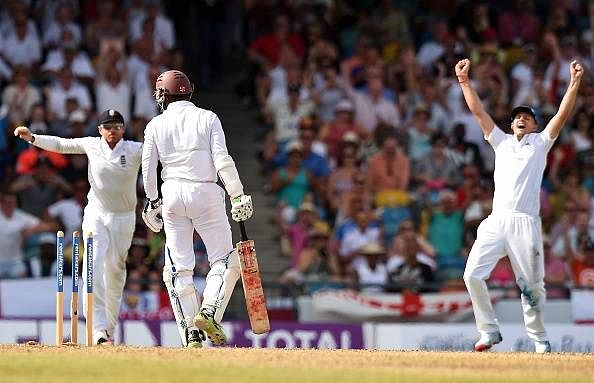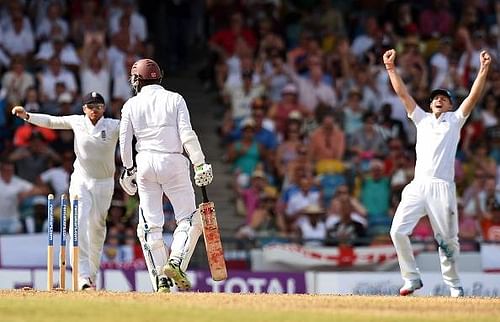
Shivnarine Chanderpaul - The unostentatious servant of West Indies Cricket

So that's it. That is probably how it will all end for Shivnarine Chanderpaul, one of the most prolific run-getters in Test match history. No emotional farewell in front of a roaring home stadium, packed to capacity, chanting his name. No elaborate tributes from team members and opposition.
The unsung hero of the West Indian side for more than two decades, Shivnarine Chanderpaul, has had his career curtailed quite brutally by the selectors, including the twice World Cup-winning former captain and fellow Guyanese Clive Lloyd, and the man whom Chanderpaul first displaced to break into the side back in '94, the current coach Phil Simmons.
In what was possibly the very last innings of his career, he was castled by one of the great swing bowlers of our time, England’s James Anderson, for 0(9). On a difficult Day five pitch at the Kensington Oval, rife with vicious turn and uneven bounce, with a match to save, one would imagine Chanderpaul getting stuck in. But no. He brought his bat down late to a screamer from Jimmy and was bowled: His forty-year-old reflexes weren't a match for that sort of bowling.
It was perhaps befitting that Chanderpaul's career ended in such an anticlimactic fashion. Shiv doesn't do dramatic farewells. In fact, Shiv doesn't do dramatic anything. Batting in the trenches for the West Indies for the latter half of two decades transformed the free-flowing aggressive batsman cum spin bowler into a defending machine. A victim of circumstance.
Shiv’s place of constancy in a troubled cricket history
The 69-ball hundred against Australia at Bourda gave the world a glimpse into what might have been had the West Indies not been in such dramatic decline through the 21st century. In some ways, Brian Lara's flashy style which led him to be hailed as perhaps West Indies' greatest batsman, was facilitated by Chanderpaul’s dogged and defensive batting style. They were the perfect foils for each other. A harmonious juxtaposition of batting styles which couldn’t be more contrarious.
It was Lara who first came to Chanderpaul’s defence when he was dropped. Lara felt that he was treated unfairly, just as many other greats were, by the WICB. It’s true. In the past, many greats were treated with shameful scorn in the Caribbean; even now players are subjected to the effects of maladministration, corruption and apathy.
Last year, this culminated in the West Indies’ abandonment of their tour of India due to disputes with the board over their pay. Caribbean cricket, though, continues to be in decline because of incompetent and indolent administrators and poor quality pitches that neither favour quick bowling nor aggressive batting, which have historically been the West Indies’ two areas of specialization. And Chanderpaul is the last remaining vestige of a bygone era where the Frank Worrell Trophy actually had some significance in the cricket calendar.
Why Chanderpaul should have been persisted with
What befits the Chanderpaul demeanour more than anything was the fact that he denounced retirement even after receiving the axe at 40. Chanderpaul believes yet that he is still among the best five or six batsmen in the region, and he's probably right. The West Indies could have used Chanderpaul’s invaluable experience at home against the Australians well.
A man who averages 90+ against Australia at home – who has done so for the last two decades without fail – was dropped because of six innings. Chanderpaul’s dressing room presence is important to a team whose most senior players at the moment are the batting enigmas, Darren Bravo and Marlon Samuels. Samuels’ commitment to the West Indian cause was always questionable. But it is now necessary to build a team with a core comprised of these players, who are still among the best in the Caribbean.
At 40, Chanderpaul’s place in the team was always going to be fragile, although just two poor series is too little time to come to so harsh a judgement about the man’s form, although he certainly isn’t the player he was a few years ago. His replacements are Rajindra Chandrika and Shane Dowrich, who average 37 and 25 respectively in first-class cricket, which really do not inspire any confidence in the selectors, or the rest of the world, that these are the players who will be the torchbearers of Caribbean cricket, and will valorously rescue it from the doldrums.
But talent available in the Caribbean at present is scant, and the West Indies have to start somewhere. Their youth-first policy demands that they give guys like Shai Hope, Shane Dowrich and Jermaine Blackwood exposure to international cricket against top quality bowling. And one cannot fault their intentions. Dowrich actually came good with a resilient, four-hour 70 which was one of the only bright spots in their three-day loss to Australia in Dominica. But Chandrika’s pair at Sabina Park was perhaps reflective of his first class average and the fact that, across more than thirty first-class games, he wasn’t able to make a century.
How does Chanderpaul go out into the sunset?
Eminent West Indians including former fast bowler Michael Holding and cricket writer Tony Cozier have praised Lloyd's brave decision and have supported his selections. Perhaps justifiably so, as a home series against the best world side is a good proving ground for these young players.
It seems unlikely that this great servant of West Indian and Guyanese cricket will ever get another chance on the international stage to go out with the respect and adulation that he deserves. Chanderpaul has vocalized his desire to leave cricket with an international game. It is conceivable that perhaps Chanderpaul wasn't meant to pass the flamboyant Lara in numbers. 86 runs isn't too many, and Chanderpaul had more than a few innings to attempt to surpass Lara’s record. But his patchy form and unsure footwork, especially to spin bowling were ominous signs for anyone who was watching.
The ever-resilient Shivnarine Chanderpaul has made himself available for selection in the forthcoming domestic season for Guyana. He has always.
He has also been a great batsman for Guyana. From throwdowns from his father Khemraj on the Atlantic coast at Demerara, where he developed his crab-like batting stance, he has come a very long way. And Guyana would be a marvelous place to call it a day. Perhaps what he needs is a quiet hometown valediction from Caribbean cricket on a sunny Georgetown day; a Bajan quick running up him, in his front-on stance, as he brings his bat down, ever so surely, impermeable in defense, congruent to the man within.